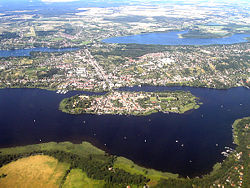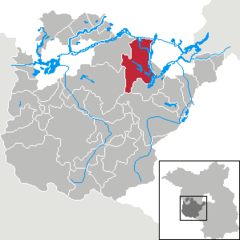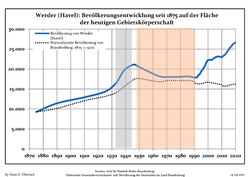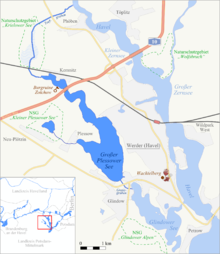
Brandenburg an der Havel is a town in Brandenburg, Germany, which served as the capital of the Margraviate of Brandenburg until it was replaced by Berlin in 1417.

Havelland is a district or county in Brandenburg, Germany. It is bounded by the districts of Ostprignitz-Ruppin and Oberhavel, the city-state of Berlin, the district of Potsdam-Mittelmark, the city of Brandenburg and the state of Saxony-Anhalt.

Potsdam-Mittelmark is a Kreis (district) in the western part of Brandenburg, Germany. Its neighbouring administrative units are the district of Havelland, the free cities of Brandenburg and Potsdam, the state of Berlin, the district of Teltow-Fläming, and the districts of Wittenberg, Anhalt-Bitterfeld and Jerichower Land in Saxony-Anhalt.

Teltow-Fläming is a Kreis (district) in the southwestern part of Brandenburg, Germany. Neighboring districts are Dahme-Spreewald, Elbe-Elster, the districts Wittenberg in Saxony-Anhalt, the district Potsdam-Mittelmark, and the Bundesland Berlin.

Kloster Lehnin, or just Lehnin, is a municipality in the German state of Brandenburg. It lies about 24 km (15 mi) west-south-west of Potsdam.

Teltow [German pronunciation:['tɛltoː] ] is a town in the Potsdam-Mittelmark district, in Brandenburg, Germany.
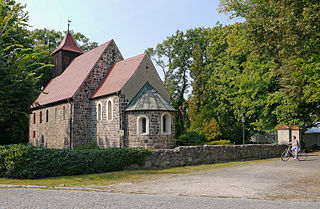
Stahnsdorf is a municipality in the Potsdam-Mittelmark district, in Brandenburg, Germany.
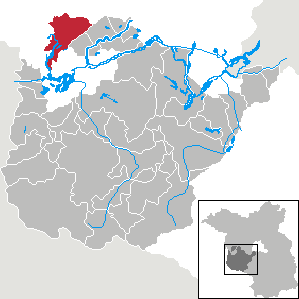
Havelsee is a town in the Potsdam-Mittelmark district, in Brandenburg, Germany. It is situated on the river Havel, 12 km northwest of Brandenburg.
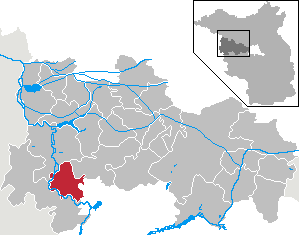
Premnitz is a town in the Havelland district, in Brandenburg, Germany. It is situated on the river Havel, 8 km south of Rathenow, 21 km northwest of Brandenburg, and is only 75 km west of central Berlin, to where it is well connected by the railway and road networks. The surrounding landscape is very rural and forested in its make up.

Groß Kreutz is a municipality in the Potsdam-Mittelmark district, in Brandenburg, Germany.

Nuthetal is a municipality in the Potsdam-Mittelmark district, in Brandenburg, Germany.

Schwielowsee is a municipality in the Potsdam-Mittelmark district, in Brandenburg, Germany. It is situated on the shore of the Schwielowsee lake, through which the River Havel flows. The municipality was founded on December 31, 2002 in merger of the three villages Caputh, Geltow and Ferch. The Caputh Ferry, a cable ferry across the Havel, links Caputh and Geltow. In the east Schwielowsee shares border with the City of Potsdam, in the west with the town of Werder (Havel).

Seddiner See is a municipality in the Potsdam-Mittelmark district, in Brandenburg, Germany.
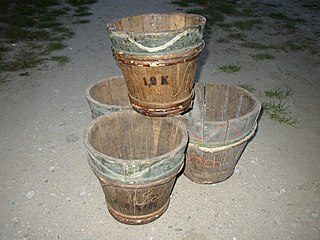
A Tiene, sometimes also called Tine or Obsttiene, was a special container for transporting wine and fruit. These were used until shortly after the First World War, mostly in the Brandenburg city of Werder in northern Germany. Normally the wooden tubs were carried on people's backs to small boats and shipped on the Havel River to market stalls in Berlin.

The Werderaner Wachtelberg is a 6.2 hectares vineyard in the town of Werder (Havel) in Brandenburg. As the northernmost outpost of the Saale-Unstrut wine region, it is the most northern registered location for QbA quality wine in Germany.

The first section of the Berlin–Magdeburg Railway was opened in 1838 as the Berlin-Potsdam Railway also known as trunk line and was the first railway line in Prussia. In 1846 it was extended to Magdeburg.
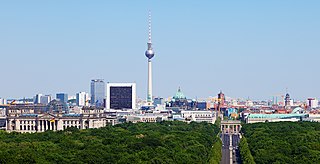
The Berlin/Brandenburg metropolitan region or capital region is one of eleven metropolitan regions of Germany, consisting of the entire territories of the state of Berlin and the surrounding state of Brandenburg. The region covers an area of 30,545 square kilometres (11,793 sq mi) with a total population of about 6.2 million.
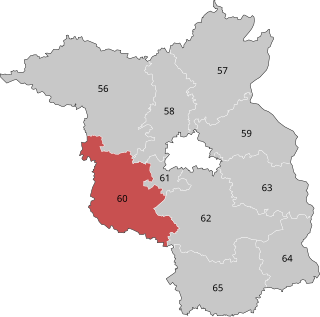
Brandenburg an der Havel – Potsdam-Mittelmark I – Havelland III – Teltow-Fläming I is an electoral constituency represented in the Bundestag. It elects one member via first-past-the-post voting. Under the current constituency numbering system, it is designated as constituency 60. It is located in western Brandenburg, comprising the city of Brandenburg an der Havel, most of the Potsdam-Mittelmark district, and parts of the Havelland and Teltow-Fläming districts.

Geographically, the Havelland is the region around which the River Havel flows in a U-shape between Oranienburg to the northeast and Rhinow to the northwest. The northern boundary of the Havelland is formed by the River Rhin and the Rhin Canal. In the history of Brandenburg, the Havelland represents a historic region.

Brandenburg an der Havel I/Potsdam-Mittelmark I is an electoral constituency represented in the Landtag of Brandenburg. It elects one member via first-past-the-post voting. Under the constituency numbering system, it is designated as constituency 16. It is located in across the city of Brandenburg an der Havel and Potsdam-Mittelmark district
